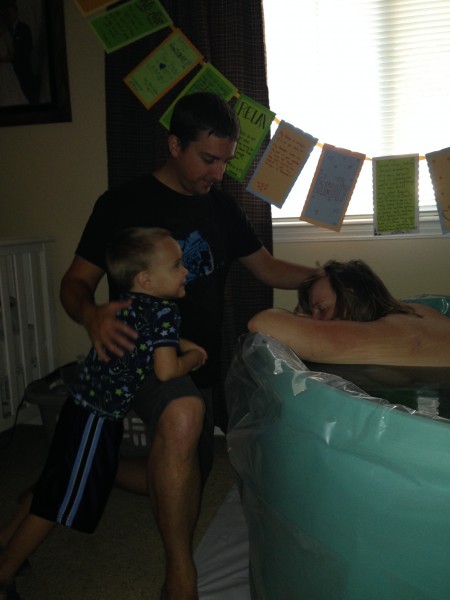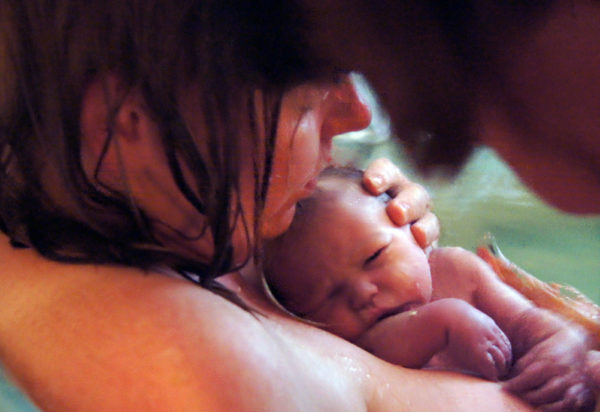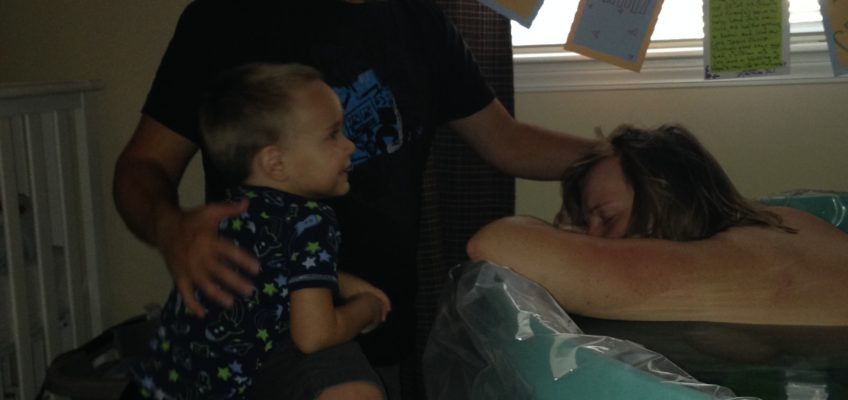This is the birth story of Emily’s third child, Edith. Edith was born at home, breech, in the water.
By Emily Willett
 Edith is an old name which means “spoils of war” or “treasure.” My Edith is exactly that. She is a sweet treasure at the end of a type of war—a battle against the opinions and protocols of the medical community and a culture that fears birth. My Treasure taught me how to be a birth warrior.
Edith is an old name which means “spoils of war” or “treasure.” My Edith is exactly that. She is a sweet treasure at the end of a type of war—a battle against the opinions and protocols of the medical community and a culture that fears birth. My Treasure taught me how to be a birth warrior.
To begin with, we didn’t know Edith was Edith. My husband and I, along with our two young boys, Rowan and Reid, simply referred to her as New Baby. We all enjoyed seeing my belly grow, especially Reid who loved to lay his head on my round belly. We went as a family to our prenatal appointments and our midwife Justine would let the kids help her. Every appointment brought the wonderful news that New Baby was growing and developing perfectly.
At about 30 weeks into my pregnancy, I began to notice that New Baby was kicking down low in the pelvis. When I would palpate my belly, I couldn’t feel the head like I thought I should be able to. At my next prenatal appointment, Justine felt around and said that the reason I was not able to feel the baby’s head was because New Baby was sitting breech in my pelvis.
At this point, neither of us was too worried about the baby being breech. Both of my boys were breech until about 34 weeks. But, at the next prenatal appointment, New Baby was still breech. This time Justine was able to feel that the baby was in a complete breech position. We spent lots of time talking about what this could mean. I had a deep feeling that there was a reason New Baby was choosing to sit this way. I did not want to attempt a version or really do anything to encourage New Baby to turn. I kept telling Justine, “Shouldn’t I be more worried than this?” She simply told me to go home and talk to my husband and decide how we wanted to proceed.
That night my husband and I talked about our breech baby, and the research and reading began. It was then that I realized how scared the medical community is by breech birth. We were able to find some studies and statistics (most studies were flawed and outdated), and we watched the few breech birth videos that are on YouTube. After lots of research, we were armed with a few distinct questions we wanted to ask our midwife. What about cord prolapse? What about stargazing? What about baby size? What about nuchal cord? How would we deal with a “stuck” baby?
Justine had experience doing breech home waterbirths. She was full of advice, knowledge and the ability to help us process our fears and figure out what the really big issues were for us regarding our decision of where and how to birth our baby. She never tried to convince us to have our baby at home. She laid down some parameters within which she was comfortable working, and at that point we were confident that we wanted to pursue a homebirth. We decided that an ultrasound would give us some additional information and hopefully allow us to have more confidence in our choices.
The ultrasound process was not pleasant. The nurse practitioner was very upset that I was still planning on having my baby at home, and she wasn’t afraid to tell me. During the scan she spent an abnormally long time scanning the baby’s head—long enough that I told her that it was hurting me. She then responded by saying that my baby’s heartbeat was tachycardic (fast). (Um, no wonder—you were just stimulating his/her head for a long time!) She asked if I was planning to come back for future prenatal visits, and I replied, “I hope not!” She then said that she wanted me to go straight up to the nurse’s clinic and get a non-stress test (NST) to track the heart tones since I wouldn’t be returning. I agreed, hoping that when they saw that everything was fine, they would let me go in peace and not write something nasty in my records. However, the NST turned into quite an ordeal. The nurses kept trying to convince me to be admitted to the hospital for observation. I declined and said that I would not do anything until I talked to the doctor who was interpreting my NST strip. When the doctor finally came in, she recognized me (I had been a doula for two births where she was the OB) and knew that I was knowledgeable about birth. She looked at the strip, said the baby looked fine and told me I should go home.
The results from the next ultrasound were slightly concerning for me. The radiologist said that New Baby was already 7 lb 3 oz, had a big head and was incomplete breech. At our next prenatal appointment, Justine talked about what this new information meant for us. I told Justine how I was not sure that we could even trust the ultrasound report since the techs seemed so uncertain about what they were doing. (It had been another unpleasant experience—the techs didn’t even know there was more than one type of breech presentation.) I had much more confidence in my midwife’s hands then the ultrasound technology. So Justine spent an extended time palpating my belly and talking to me about what she could feel and what her experience told her. She was still convinced that New Baby was in a complete breech position. As for the size of the baby, she just recommended that I eat lots of veggies and limit my sugar and carbohydrates. She told me that at some point, after all the research, worrying and trying to figure out all of the possible outcomes, I would reach a point of being at peace and then I would be ready to have my baby. I was excited to get to that peaceful place.
The last two weeks of my pregnancy came and went. My friends threw me a Blessingway that brought me renewed strength and joy. New Baby stayed breech and we prepared for our homebirth. Putting up the birth pool gave us a great opportunity to talk to the boys about the birth. We told them I would sound like a mama bear because it was hard work to push a baby out. Reid, who had a wonderful connection with New Baby due to the time he spent on my belly, simply said that the baby was “going to slide right out.” I sure hoped he was right.
Week 39 came and we were all starting to guess what New Baby’s birthday was going to be. I really wanted to have the baby sooner than later as I was concerned that he/she would be getting too big to birth vaginally. Reid was certain the baby would be born on Saturday. I was starting to bet on him.
On Friday night, September 20, right before midnight, I awoke suddenly to a “pop” and told my husband, Bryon, that something had happened. “My water broke!” We called Justine and updated her. During the next 30 minutes, I had 5 contractions, so we called Justine again and she was on her way.
 Contractions had completely stopped by the time Justine arrived. She took my vitals and checked me to see how the baby was presenting and to see if there was space for the cord to slip down. She could feel that I was about 2 cm and that the baby was firmly applied to my cervix and there was no cord between the baby and the cervix—good news! She told me to snuggle with my husband and sleep while she rested on our couch. I slept until about 4 am, then I got up to use the bathroom and decided to stay sitting up for a bit. That is when my contractions started. They were 3 minutes apart and lasting about 60 seconds. I sat breathing quietly through each one for about an hour. Justine must have heard me breathing because she came in the room to check on me. She took my vitals again and I updated her on how I was feeling and what the contractions were doing. She sat quietly, charted and watched and encouraged me. I told her I was a bit nervous to change my position because I was afraid the contractions would go away. She reminded me that movement in early labor is a good thing, so I got up and stood by the crib that was next to our bed. The contractions got more intense very quickly. It was about 6 am and we decided it was time to call our support team. My mom and another midwife, who was coming to observe, were on their way.
Contractions had completely stopped by the time Justine arrived. She took my vitals and checked me to see how the baby was presenting and to see if there was space for the cord to slip down. She could feel that I was about 2 cm and that the baby was firmly applied to my cervix and there was no cord between the baby and the cervix—good news! She told me to snuggle with my husband and sleep while she rested on our couch. I slept until about 4 am, then I got up to use the bathroom and decided to stay sitting up for a bit. That is when my contractions started. They were 3 minutes apart and lasting about 60 seconds. I sat breathing quietly through each one for about an hour. Justine must have heard me breathing because she came in the room to check on me. She took my vitals again and I updated her on how I was feeling and what the contractions were doing. She sat quietly, charted and watched and encouraged me. I told her I was a bit nervous to change my position because I was afraid the contractions would go away. She reminded me that movement in early labor is a good thing, so I got up and stood by the crib that was next to our bed. The contractions got more intense very quickly. It was about 6 am and we decided it was time to call our support team. My mom and another midwife, who was coming to observe, were on their way.
It wasn’t long before I was swaying and moaning though the contractions. My husband was busy hooking up the hose to fill the pool. It was becoming evident that the pool needed to be filled as quickly as possible if it was going to be ready in time.
My boys were in and out of the room. My mom said that at one point Rowan told her that I sounded more like a dinosaur than a bear. During all of this, Bryon was trying to set up the video camera because I had decided that there were not enough breech birth videos. We wanted to film this birth so it could serve as an educational tool.
At some point, I felt increasing pressure and really wanted to get in the pool. I got into the hands and knees position and soon felt the urge to push. I had pushed out two vertex babies in the past, but pushing this baby was very different. I had guttural, body-shaking, roaring kind of pushes. The back end of my body would float and I would support my upper body with my hands and draw my knees up to my chest. This was hard work! Reid came in to put a wash cloth on my head and bring me some water. At this point I remember noticing that I felt a lot more lucid between contractions during this birth than with the boys.
After a few more contractions I asked Justine if any part of the baby was past my cervix. (I wasn’t sure if I was making any progress.) She said, “Oh, yes. Can’t you feel the pressure? With the next contraction, reach down and feel your baby.” I couldn’t believe New Baby was getting that close. I felt what must have been the start of the baby rumping—the start of the crucial time. If something happened, we had about five minutes to get this baby out without risking brain damage. So I pushed like a primal, mad woman! I pushed into that incredibly intense burning sensation…and I kept pushing and breathing and growling.
“Push into your bottom,” Justine would say.
“You’re doing it! Good job!” my husband would say. I was surprisingly really at peace with what was happening. I just had to keep pushing.
Then all of a sudden, Justine said, “There’s the bottom.” From my research it usually takes a few minutes/contractions for the frank breech baby to go from rumping to being born to the umbilicus. So this is what I was expecting. But then I heard, “There are the arms…Emily, reach down and grab your baby!” I caught my own breech baby in the water in my bedroom. I cradled my new baby to my chest and waited to hear the first cry and big breath. Then, at last, there it was and I was content. I wanted to know who this wonderful new person was, so I held New Baby up and met Edith for the first time. “It’s a girl!” I remember smiling so hard that my cheeks hurt. After only three hours of labor, our family had added a new baby girl.

I spent a few minutes falling in love with Edith. Her brothers came in to meet her. Reid was right; she did slide right out into the pool. They were totally in awe of their new sister.
Edith was perfect in every way possible. She weighed 7 lbs 4 oz (the ultrasound was saying that that was her weight weeks ago). She wasn’t stargazing, had no nuchal cord and didn’t get stuck. I had no tearing and felt amazing just minutes after her arrival. Her birth was so smooth and peaceful—I truly expected there to be at least a small complication that had to be managed by our midwife. But, there wasn’t. My body knew how to have this baby and my baby girl knew how to be born. Edith was my treasure—the spoils of my labor.
Emily Willett is an al dente mother, navigating the space between ultra-crunchiness and mainstream mothering. She is a birth doula, childbirth educator, breastfeeding peer counselor and founder of Mommy Matters, which was created in 2011 with the hope of educating and supporting mothers in her community. Emily is passionate about helping mothers find their voice and confidence while following their unique parenting path.
This story was originally published in Midwifery Today: “The Breech Birth of Edith.” Willett, Emily. Midwifery Today, Issue 109, copyright Spring 2013 Midwifery Today, Inc.
Resources + Notes on Breech Birth
The ACOG’s position on breech birth is “The decision regarding the mode of delivery should depend on the experience of the health care provider. Cesarean delivery will be the preferred mode of delivery for most physicians because of the diminishing expertise in vaginal breech delivery.”
This diminishing expertise, or lack or providers offering vaginal breech birth is increasing the number of women that are being coerced in cesarean delivery of their breech babies. Only 10% of women in the U.S. who have had cesareans go onto or have access to have a vaginal birth after cesarean (VBAC) – birth choices in every situation has far reaching consequences for you, your baby and future pregnancies and births. We so grateful to the women that share their stories of vaginal breech birth, and the need for providers to continue to practice and learn the techniques of catching a breech baby.
Science does support the choice of vaginal breech birth – “establishing enhanced training and standards for those who support planned breech births may help protect users and providers of maternity services, while introducing greater choice and flexibility for women seeking the option of vaginal breech birth.”
In Canada the Society of Obstetricians and Gynecologist says: “it was common for most breech babies to be delivered through a caesarean section (C-section). With this method, the baby is delivered through incisions made in the mother’s stomach. Today, health-care professionals recommend that in some circumstances, breech babies may be delivered the traditional way, through the vagina. Vaginal childbirth has health benefits for the mother such as a faster recovery and less pain, as well as a better chance of having a vaginal childbirth in the future.”










Justine
What a brave mother & family! Thank you for sharing!